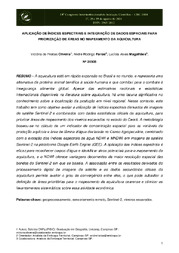Aplicação de índices espectrais e integração de dados espaciais para priorização de áreas no mapeamento da aquicultura.
Aplicação de índices espectrais e integração de dados espaciais para priorização de áreas no mapeamento da aquicultura.
Author(s): OLIVEIRA, V. DE F.; FARIAS, A. R.; MAGALHÃES, L. A.
Summary: Resumo: A aquicultura está em rápida expansão no Brasil e no mundo, e representa uma alternativa de proteína animal benéfica à saúde humana e que contribui para o combate à insegurança alimentar global. Apesar das estimativas nacionais e estatísticas internacionais disponíveis na literatura sobre aquicultura, há uma lacuna significativa no conhecimento sobre a localização da produção em nível regional. Nesse contexto, este trabalho tem como objetivo avaliar a utilização de índices espectrais derivados de imagens de satélite Sentinel-2 e combinados com dados estatísticos oficiais da aquicultura, para priorizar áreas de mapeamento dos viveiros escavados no estado do Ceará. A metodologia baseou-se no cálculo de um indicador de concentração espacial para as variáveis de produção aquícola e área de lâmina d’água declarada no Censo Agropecuário, combinado com a extração dos índices espectrais de água NDWI e MNDWI em imagens de satélite Sentinel-2 na plataforma Google Earth Engine (GEE). A aplicação dos índices espectrais é eficaz para reconhecer corpos d’água e identificar alvos potenciais para o mapeamento da aquicultura, e o NDWI oferece vantagens decorrentes da maior resolução espacial das bandas do Sentinel-2 em que se baseia. A associação entre os resultados derivados do processamento digital de imagens de satélite e os dados secundários oficiais da aquicultura permite avaliar o grau de convergência entre eles, o que pode subsidiar a definição de áreas prioritárias para o mapeamento da aquicultura cearense e otimizar os levantamentos sistemáticos sobre essa atividade econômica. Abstract: Aquaculture is rapidly expanding in Brazil and worldwide, and is an alternative source of animal protein beneficial to human health and which contributes to fight global food insecurity. Despite national estimates and international statistics available in the literature on aquaculture, there is a significant gap in knowledge regarding the location of regional production. In this context, this study aims to evaluate the use of spectral indices derived from Sentinel-2 satellite images and combined with official aquaculture statistical data, to prioritize mapping areas of excavated ponds in the state of Ceará. The methodology was based on the calculation of a spatial concentration indicator for aquaculture production variables and the area of water bodies declared in the Agricultural Census, combined with the extraction of water spectral indices NDWI and MNDWI from Sentinel-2 satellite images on the Google Earth Engine (GEE) platform. The application of spectral indices proved to be effective for recognizing water bodies and identifying potential targets for aquaculture mapping, and NDWI offers advantages due to the higher spatial resolution of the Sentinel-2 bands it is based on. Associating the results derived from digital satellite image processing and the official secondary aquaculture data enables evaluating the degree of convergence between them, which can support the definition of priority areas for mapping aquaculture in Ceará and optimize systematic surveys of this economic activity.
Publication year: 2024
Types of publication: Paper in annals and proceedings
Unit: Embrapa Territorial
Observation
Some of Embrapa's publications are published as ePub files. To read them, use or download one of the following free software options to your computer or mobile device. Android: Google Play Books; IOS: iBooks; Windows and Linux: Calibre.
Access other publications
Access the Agricultural Research Database (BDPA) to consult Embrapa's full library collection and records.
Visit Embrapa Bookstore to purchase books and other publications sold by Embrapa.

